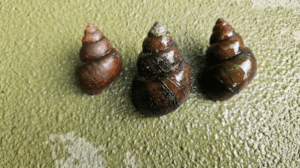How To Report Mystery Snails in Lake Lanier
Mystery Snails in Lake Lanier
If you see them, report them to Georgia DNR!
LLA has been in contact with multiple officials at Georgia DNR and we’re bringing you an update, along with reporting details, regarding the mystery species. Below is some information from DNR’s malacologist (mussel/claims/snail expert), regarding the mystery snails. Keep reading to learn more!
 Mystery snails are fairly easy to distinguish from most of our native snails. Adults [mystery snails] are typically 2-3 inches long and none of our native species get much larger than 1 inch. There are a few native snails that look similar to these non-native mystery snails, however, so some care should be taken. They are olive green as adults and, like other members of their family, have an operculum or “trap door” that they can close when them pull in their foot.
Mystery snails are fairly easy to distinguish from most of our native snails. Adults [mystery snails] are typically 2-3 inches long and none of our native species get much larger than 1 inch. There are a few native snails that look similar to these non-native mystery snails, however, so some care should be taken. They are olive green as adults and, like other members of their family, have an operculum or “trap door” that they can close when them pull in their foot.
Juveniles look quite different in that their spire is much lower and they appear clear or light green, sometimes with a dark band. At that stage they are very fragile and can appear transparent. They grow quickly and usually occur in large numbers where found.
Mystery snails are great invaders partially because their habitat requirements are not very specific. They can thrive in muddy or sandy bottoms as well as on hard surfaces like rip rap and bedrock. Typically they seem to prefer a mix of silty sand with cobble/boulder areas. All very abundant habitats in Lake Lanier. I would say they only thing really limiting their ability to colonize the lake is depths that lack oxygen.
In regards to removal, there is unfortunately very little that can be done once they are established. Methods that would eliminate them would also eliminate native mollusks and other native aquatic invertebrates. Adults and juveniles are capable of burrowing and are very effective at hiding in hard to reach places. They are also capable of surviving out of water for up to two weeks in a cool humid environment and “clamming up” and waiting out unfavorable conditions or chemical treatments so they are quite resilient.

The current primary concern over this species is the potential for parasites that could be detrimental to other wildlife and in some cases humans. GADNR is currently collaborating with Dr. Tyler Achatz at Middle Georgia State College to assess the parasites present in the various new populations of invasive mystery snails in Georgia. That effort is ongoing.
As to guidance on what to do as a landowner or user of the resource, there isn’t a whole lot that can or should be done. Reporting new sightings to DNR would be the most useful action so that we can monitor the impact of the invasion as it progresses. Certainly, don’t collect, transport, or eat the snails as they are easily moved to new areas and could potentially carry some unpleasant parasites that can transfer to humans. Additionally, they were added to the prohibited animals list last year in Georgia, so it is currently unlawful to possess them. This was done in an effort to prevent their continued spread around the state and avoid this scenario from occurring in other places.
If you see something, say something!
LLA encourages you to report potential sighting of the mystery snails. Please use the following information to submit a report to DNR:
Send report to:
Anthony Rabern at Anthony.Rabern@dnr.ga.gov Region 2 Supervisor, Fisheries
Reports should include:
- Your Name
- Phone Number
- Email Address
- Picture(s) of the snail(s)
- GPS coordinate or some kind of landmark / reference point


